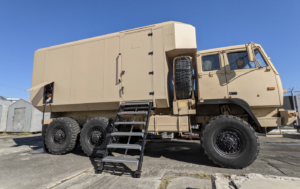ABERDEEN PROVING GROUND, Md. —The Army is pursuing two variants of its future intelligence ground station, the Tactical Intelligence Targeting Access Node (TITAN), starting with an “Advanced” version on heavier platforms such as tactical trucks with space direct downlink capability and a “Basic” model designed for platforms such as the Joint Light Tactical Vehicle (JLTV).
Maj. Jermaine Wright, assistant product manager for TITAN, said the Army will likely procure six Advanced and five Basic TITAN prototypes once it selects a winner for the competition between Palantir Technologies
[PLTR] and Raytheon Intelligence and Space [RTX], with plans to move into production in fiscal year 2026.

“TITAN Advanced operates on five enclaves. Currently, it will be on an FMTV M1083 [truck] platform. And then the Basic variant, which will we get to in prototype maturation once we get to our preferred vendor post-upselect at the end of this phase, will be on a JLTV platform,” Wright told reporters during a media event here. “The TITAN Basic will not have that space direct downlink. The technology is not there as far as antennas and whatnot. So what they will have is space access via the hubspoke network and a redundant communications network architecture to provide that space data.”
TITAN Basic will operate on the unclassified NIPRNet, the classified SIPRNet and the Mission Partner environment while the Advanced variant will function on those three enclaves as well as JWICS for top secret communications and NSANet, according to Wright.
The TITAN program is expected to deliver scalable and expeditionary intelligence ground stations capable of providing fused sensor data to weapons systems at the battalion level, with the Army describing the future system as “a crucial component to enable deep sensing and [shortening] the sensor-to-shooter loop.”
In late June, Palantir and Raytheon each received $36 million, 14-month deals from the Army to build prototypes for evaluation and testing after both companies participated in an initial phase to work through their designs (Defense Daily, June 28).
“At the end of this phase we will have two [TITAN] Advanced prototypes being delivered. But we’ll be taking the preferred winning vendor solution forward and we will continue to iterate with that agile process with that system,” Wright said.
Northrop Grumman [NOC] has also developed a TITAN “Pre-Prototype” (TPP), which officials described as a component kit that will allow the ground station to integrate with space-based capabilities.
“We’ll be taking that smaller form factor TPP and taking that as a space-ground component kit which will be integrated into both [Palantir and Raytheon’s] designs during this phase. That’s giving TITAN Advanced a space direct downlink. With JLTV and the Basic variant, it will have space access via that hubspoke network. That’s very important because TITAN’s built around the future fight and deep sensing and being able to take in that data from space to get enable long-range precision fires and targeting,” Wright said.
The Army selected Northrop Grumman to work on TITAN in 2020, noting the prototype could prove out the potential for utilizing space assets, such as low-Earth orbit satellites, to improve situational awareness and tactical intelligence in contested environments (Defense Daily, Sept. 1 2020).
Mark Kitz, head of the Program Executive Office Intelligence Electronic Warfare & Sensors, told reporters the Army’s first Multi-Domain Task Force (MDTF) based out of Joint Base Lewis-McChord in Washington has the TPP space-ground component kit and will utilize it at the next Project Convergence this fall, with another TPP going to the second MDTF in Europe.
“They will organically operate it. It is a capability that we have delivered to them. It is our first full-up prototype delivering integrated data to analyst shooter, whoever the consumer is. One of the really exciting things is the actual first MDTF users are integrating those data sensors and those data feeds,” Kitz said.
TITAN is intended to replace four legacy ground stations currently in the field, the Advanced Remote Ground Terminal (RGT), Advanced Miniaturized Data Acquisition System Dissemination Vehicle (ADV), Tactical Intelligence Ground Station (TGS) and Ground Station, Operational Intelligence (OGS), according to Wright.
“Those four legacy ground stations just do not have the usability, ease of use, to meet [Multi-Domain Operations],” Wright said. “That’s what TITAN is built for, it’s that next-generation ISR ground station that’s going to have Modular Open Systems Architecture to be able to continue to bring in those mature, emerging technologies over the life of the program.”
Doug Bush, the Army’s top acquisition official, recently cited TITAN as an example of a capability the service is working on that could service as a key piece of JADC2 (Defense Daily, July 11).
“[TITAN] is an intel fusion capability…that will be critical to whatever JADC2 becomes,” Bush said in July.